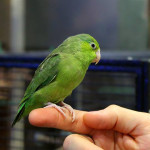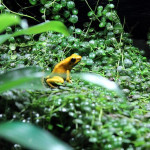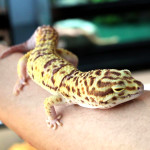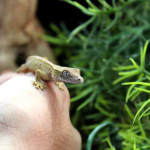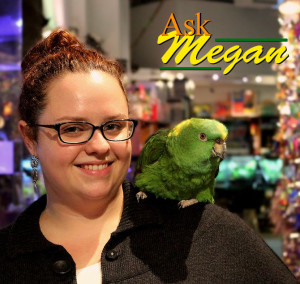 Fauna staff member, Megan Sweeney, is an important source of information for our customers. Here are her answers to some of our customer’s most frequently asked questions:
Fauna staff member, Megan Sweeney, is an important source of information for our customers. Here are her answers to some of our customer’s most frequently asked questions:
If you would like your question considered for this page, please EMAIL us and put “Ask Megan” in the subject line. Call the store for answers to immediate questions – (212) 877-2473.
(Click images to enlarge)
Q: Are your birds captive bred or wild caught? And how do you tell the difference?
A: All of the birds that we sell at the store are captive raised by us. In 1992, the US Fish & Wildlife Service enacted the Wild Bird Conservation Act, which prohibits importation of exotic birds except for zoos or other approved institutions. There is also a New York State Law that requires all birds, with the exception of certain common species (cockatiels, budgies, lovebirds and some finches), sold within the state be banded with a closed leg band. A closed leg band of appropriate size must be placed on a baby bird’s leg, usually by the time they are three weeks old, before their foot has grown too large to place or remove the band. This is how you can quickly see that a bird was captive bred!
Q: Are poison dart frogs poisonous in captivity?
A: Poison dart frogs are generally not poisonous in captivity. The frogs actually develop the toxin within their skin with the aid of chemical compounds from the insects they would naturally eat in the wild. Our captive raised dart frogs eat fruit flies, crickets and occasional phoenix worms which do not contain the key compounds to develop the toxin. Even though they are not poisonous in captivity, handling of most amphibians should be done with extreme caution and is generally not recommended because they easily absorb things through their skin that can cause harm or even death to the animal.
Q: I’m a first time reptile owner and have two small children. I’m looking for a low maintenance pet that is great with kids. What would be the best reptile to suit my needs?
A: I would recommend a bearded dragon or a leopard gecko. Both species are great starter reptiles because they are relatively low maintenance and can be handled by the entire family. Bearded dragons are extremely well behaved pets and love to lay around with their owners. They do, however, get fairly sizable (around 12-24 inches from head to tail) and therefore need a large enclosure. Another great thing about bearded dragons is that as they grow older, they primarily eat greens, vegetables and small amounts of fruit and insects. A balanced diet will ensure your “beardy” will live up to 10 years or more!
Leopard geckos are also very low maintenance pets and they don’t take up very much room. Long terrariums such as a 20 gallon-long tank are the ideal set-up for a leopard gecko, since they do not climb as much as other reptiles. All they need is a cave to hide from their lights, and a few decorations such as plants or driftwood. These reptiles will live anywhere from 10-20 years!
Both of these reptiles require a UVB day lamp and an infrared nighttime heat lamp. These lights prevent your animal from getting too cold and helps them absorb calcium from the food they eat. Because both of these species of reptiles are normally found in the desert, the temperatures of their tank need to stay between 77 and 88 degrees, with a basking spot of 95 to 105 degrees. This will ensure your reptile will live a long and healthy life!
Q: I’m a student and want a reptile I can keep in my dorm room that does not require a lot of space or heat. I would also prefer if it did not primarily eat insects. What’s the best pet for me?
A: I would recommend a crested gecko because they are relatively low maintenance. They also do not require a huge tank or a heat bulb at night like many reptiles. The only light they require would be a 2.0 or 5.0 UVB bulb during the day. They thrive at a temperature of about 75 degrees, but do require high humidity, around 70-85%. You can either buy a water mister and hand mist them a few times a day, or you could buy a fogging machine that can automatically mist the tank for you. Repashy Crested Gecko diet is their main food source, which should be changed nightly, as they tend to eat at night. They can be a little jumpy as juveniles but with care and handling they become quite tame as adults. Be ready to love your crestie for a long time because they live 10-20 years!
If you would like your question considered for this page, please EMAIL us and put “Ask Megan” in the subject line. Call the store for answers to immediate questions – (212) 877-2473.
.
![]()
![]()
![]()
![]()
![]() To learn more about Fauna NYC, visit our website! Sign up for our eNewsletter for new animal arrivals, product discounts, and upcoming events.
To learn more about Fauna NYC, visit our website! Sign up for our eNewsletter for new animal arrivals, product discounts, and upcoming events.

